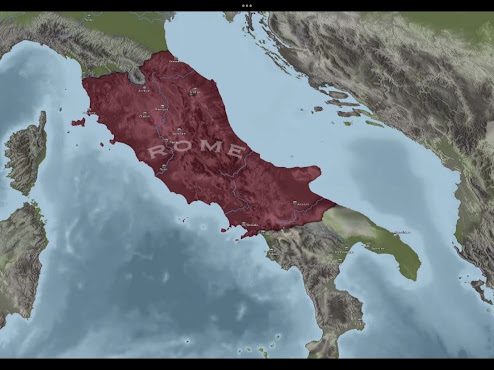The Roman war against the Latin tribes
How Rome took control of Italy? In the beginning of the Republican age Rome was surrounded by a group of tribes called “Latin league”
Scattered to the south and north of Rome. These tribes were launching raids on Rome to reduce the risk of its transformation into a superpower. These wars between Rome and Latin league occurred in the 5th and 4th centuries B.C and ended in most of them with the Roman victory, leading to dissolution of the Latin league in 338 B.C.
The Roman Republic after the Latin war
The Gallic wars
390 B.C the war between the developing Roman Republic and the Gallic tribes reached its peak. The Gallic tribes was in control of the northern part of Italy which was called “ Cisalpine Gaul “. 390 B.C a Gallic tribe attacked the city of Clusium, a Roman ally. The inhabitants of Clusium sought support from Rome. The Romans agreed. The battle of Alia between Rome and Gauls occurred in 390 B.C ended with humiliating defeat to the Romans. A few days later, the Gauls marched to Rome and managed to sack and burn it. But the Romans raised an army at city of Veil under the command of Marcus Furuis Camilus to retake the city. Indeed the Romans managed to expel the Gauls out of it.
Sack of Rome by the Gauls
The Samnite war
The Samnite was one of the Latin tribes in south east Italy. Despite the peace treaties between Rome and the Samnites, they involved in war in 327 B.C. This war continued for twenty years and Rome emerged victorious leading to Roman’s control of most of south east of Italy in 305 B.C
The Roman Republic after the Samnite warPyrrhic war
Pyrrhic war was between Rome and Epirus, in western Greece, when the the city of Tarentum, a Greek colony in southern Italy sought help from Pyrrhus of Epirus against Rome. The war continued five years between 280-275 B.C, where the Greeks used elephants which Romans have no experiment to deal with.
Pyrrhus of EpirusThe war begin successfully for Greeks as they won the battle of Heraclea in 280 B.C.
The battle of HeracliaOne year later, the battle of Asculum took place in the city of Apolia on the Adriatic coast ending with Greek victory and 6000 losses for the Romans. Despite the Pyrrhus victory, he lost almost 3500 soldiers which forced him to go back to Tarentum in the south.
The battle of Asculum
After the decisive defeat of Asculum, the Romans Were forced to make an alliance with the Carthaginians. The reason beyond Carthage approval to make an alliance with Rome was fear of Pyrrhus intervention in Sicily which its western parts were under Carthage’s control.
In 278 B.C, Pyrrhus receive a delegation from Greek cities in eastern Sicily to help them fight the Carthaginians who were besieging the city of Syracuse, one of the Greek cities in the eastern Sicily. After receiving the delegation, the Epirite king decided to sail into Sicily with an army of 8000 infantry and 2000 cavalry. The ships docked on the eastern coast of the island at city of Tauromenium after the king of the city declared his alliance with Pyrrhus of Epirus.
Afterward, Pyrrhus set sail into the city of Catana where its inhabitants received him as a liberator from the Carthaginians and provided him with 3000 soldiers. Thereupon, the Pyrrhus made an amphibious attack on the city of Syracuse causing the Carthaginians to break the siege and retreat to the west of the island. Afterward, the Greek king set out west to the city of Agrigentum, where its king also declared his loyalty to Pyrrhus. Pyrrhus continued to march westward where both city of cilinus and syxta surrendered without a fight. The Eprite king tried after that to launch an attack on the city of Eryx on the western coast of Sicily and besiege it, after short period the city fell into the Greeks’ hands. Short after, he marched into Lilybaeum, the last Carthaginians’ strongholds in Sicily, and after a long siege, he didn’t mange to storm the city as it was well fortified. At the same time, Pyrrhus knew that the Romans attacked the city of Tarentum in Italy, forcing him to abandon the siege and set sail to Italy. After he returned to Italy, he assembled an army and marched north to confront the Romans. The Roman army was divided into tow parts. One of them was in in city of Lucania while the other was in Beneventum. So, Pyrrhus also divided his army into tow parts, one of them headed out to Lucania while the other, which was under the command of Pyrrhus himself marched to Beneventum with a strength of 35000 soldiers to meet the Roman army which consist of 25000 soldiers under the command of Manuis Curuis Dentuis. The Romans emerged victorious and Pyrrhus forced to retreat to his kingdom in Epirus. Between 274 and 272 B.C Pyrrhus has conducted numerous military campaigns in Macedonia and Sparta ended by his killing while he was besieging Sparta in 272 B.C.
See the Arabic translation 👇
https://historynerdmontedher.blogspot.com/2022/07/latin-league.html







No comments:
Post a Comment